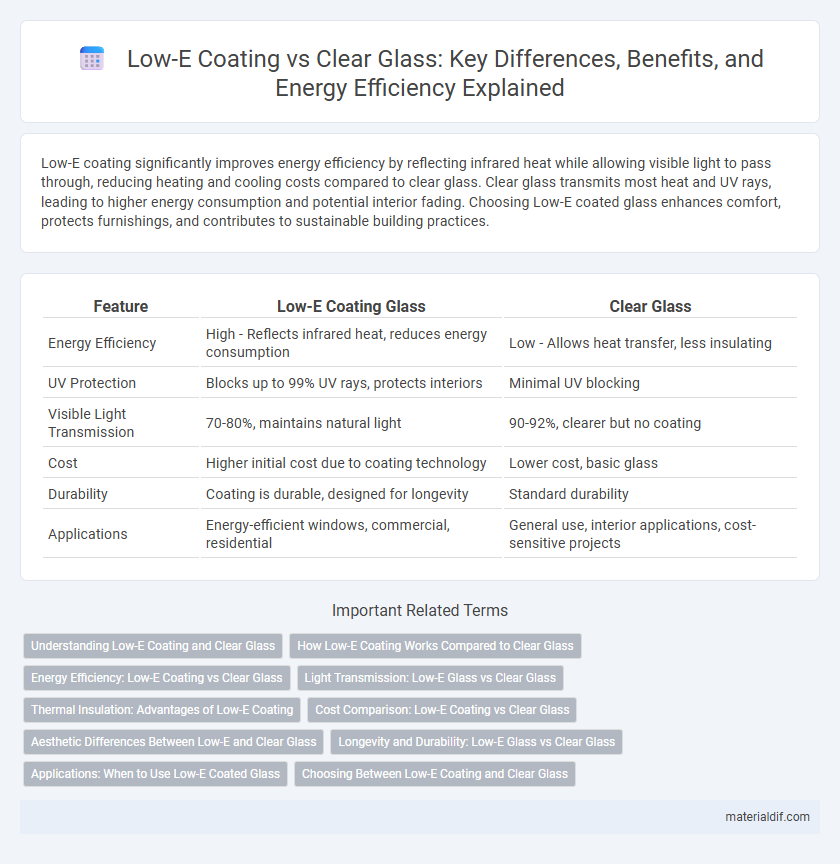Low-E coating significantly improves energy efficiency by reflecting infrared heat while allowing visible light to pass through, reducing heating and cooling costs compared to clear glass. Clear glass transmits most heat and UV rays, leading to higher energy consumption and potential interior fading. Choosing Low-E coated glass enhances comfort, protects furnishings, and contributes to sustainable building practices.
Table of Comparison
| Feature | Low-E Coating Glass | Clear Glass |
|---|---|---|
| Energy Efficiency | High - Reflects infrared heat, reduces energy consumption | Low - Allows heat transfer, less insulating |
| UV Protection | Blocks up to 99% UV rays, protects interiors | Minimal UV blocking |
| Visible Light Transmission | 70-80%, maintains natural light | 90-92%, clearer but no coating |
| Cost | Higher initial cost due to coating technology | Lower cost, basic glass |
| Durability | Coating is durable, designed for longevity | Standard durability |
| Applications | Energy-efficient windows, commercial, residential | General use, interior applications, cost-sensitive projects |
Understanding Low-E Coating and Clear Glass
Low-E coating enhances clear glass by reflecting infrared and ultraviolet light while allowing visible light to pass through, improving energy efficiency and reducing heat transfer. Clear glass, in contrast, lacks this selective reflective layer, making it more prone to heat gain and loss, which can increase energy consumption. Understanding these differences helps optimize window performance in residential and commercial buildings for better thermal insulation and comfort.
How Low-E Coating Works Compared to Clear Glass
Low-E coating on glass utilizes microscopically thin metallic layers to reflect infrared light while allowing visible light to pass through, significantly enhancing thermal insulation compared to clear glass. Clear glass transmits most infrared radiation, leading to greater heat transfer and energy loss through windows. By reducing UV and infrared penetration, Low-E coated glass improves energy efficiency and indoor comfort without compromising natural light.
Energy Efficiency: Low-E Coating vs Clear Glass
Low-E coating significantly improves energy efficiency by reducing heat transfer through windows, maintaining indoor temperatures and lowering heating and cooling costs compared to clear glass. Clear glass allows more solar heat gain and infrared radiation to pass, resulting in higher energy consumption for climate control. Using Low-E coated glass contributes to sustainable building designs by enhancing thermal insulation and minimizing reliance on HVAC systems.
Light Transmission: Low-E Glass vs Clear Glass
Low-E glass typically transmits between 70-80% of visible light, balancing natural illumination with energy efficiency, while clear glass allows about 90% or more of visible light to pass through, maximizing brightness. The selective coating on Low-E glass reduces infrared and ultraviolet light transmission without compromising much visible light, enhancing indoor comfort by minimizing heat gain and loss. Clear glass, lacking such coatings, offers higher light transmission but less control over thermal performance and UV protection.
Thermal Insulation: Advantages of Low-E Coating
Low-E coating significantly enhances thermal insulation by reflecting infrared heat while allowing natural light to pass through, reducing energy consumption for heating and cooling. Unlike clear glass, which transmits a higher percentage of radiant heat, Low-E coatings minimize heat transfer, improving indoor comfort and lowering utility bills. This thermal barrier performance makes Low-E coated glass ideal for energy-efficient building designs and sustainable construction.
Cost Comparison: Low-E Coating vs Clear Glass
Low-E coating typically increases the upfront cost by 10-20% compared to clear glass due to advanced manufacturing processes. However, the energy savings from reduced heat transfer can lower utility bills by up to 30% annually, offsetting initial expenses over time. Clear glass remains a cheaper option initially but lacks the thermal efficiency benefits provided by Low-E coatings.
Aesthetic Differences Between Low-E and Clear Glass
Low-E coating enhances glass by reducing glare and providing a subtle tint that improves visual comfort without compromising natural light, creating a more elegant appearance than clear glass. Clear glass offers maximum transparency and brightness but can cause harsh reflections and a less refined look. The low-E glass surface tends to have a slight reflective quality that adds depth and sophistication to building aesthetics.
Longevity and Durability: Low-E Glass vs Clear Glass
Low-E glass features a specialized coating that enhances its resistance to scratches, weathering, and UV damage, resulting in a longer lifespan compared to clear glass. Clear glass lacks this protective layer, making it more vulnerable to degradation and less durable over time. The enhanced durability of Low-E glass contributes to reduced maintenance costs and sustained energy efficiency throughout its usage.
Applications: When to Use Low-E Coated Glass
Low-E coated glass is ideal for energy-efficient building applications, effectively reducing heat transfer and enhancing insulation in both residential and commercial windows. In climates with extreme temperatures, Low-E glass helps maintain indoor comfort by blocking ultraviolet and infrared rays while allowing natural light to pass through. Clear glass, lacking these properties, is preferred in situations where cost is a priority or maximum transparency is required without thermal performance considerations.
Choosing Between Low-E Coating and Clear Glass
Low-E coating significantly reduces heat transfer by reflecting infrared energy while allowing visible light to pass through, making it an energy-efficient choice compared to clear glass. Clear glass, lacking specialized coatings, offers higher solar heat gain and lower insulation values, which can increase heating and cooling costs. Selecting Low-E glass enhances thermal comfort and reduces energy consumption, ideal for climates with extreme temperatures, whereas clear glass may be chosen for maximum clarity and lower initial cost.
Low-E coating vs Clear glass Infographic

 materialdif.com
materialdif.com